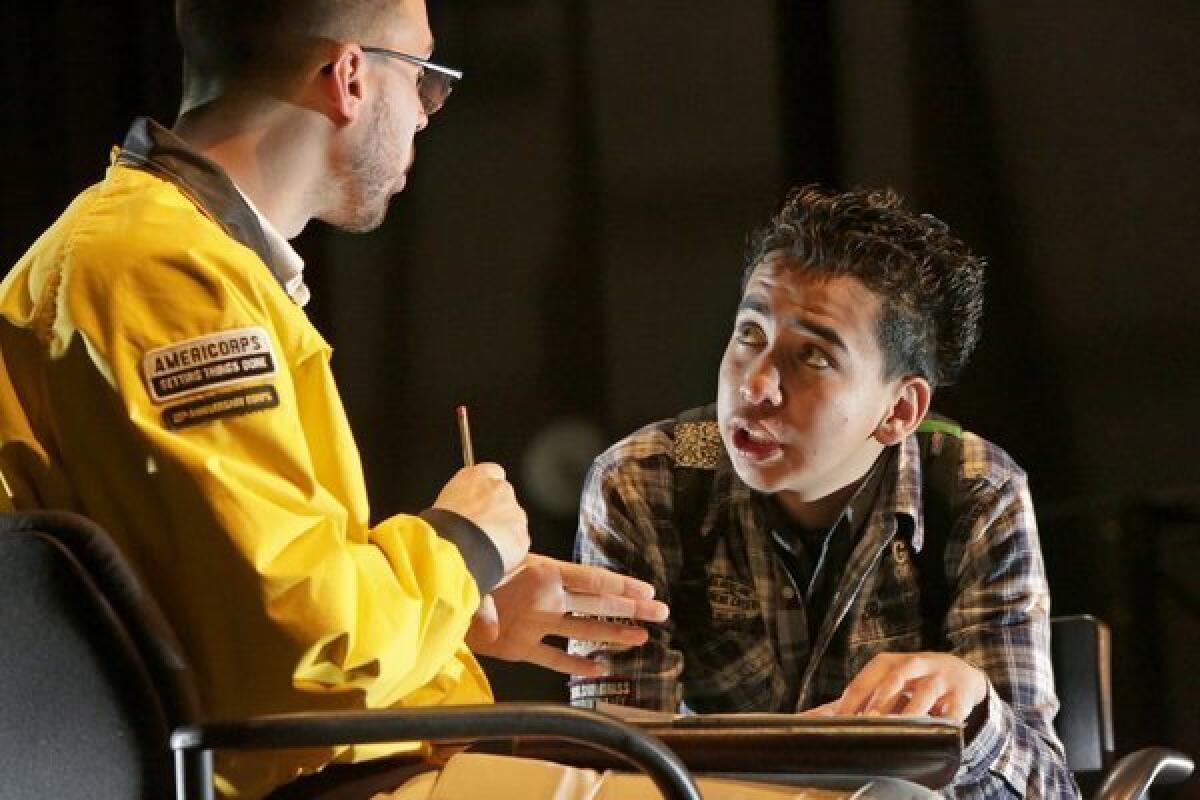Mentoring group gives L.A. Unified students an extra way to connect

Joe Zeccola’s classroom at Santee Education Complex is crammed full with 43 desks. When class is in session, students occupy every seat.
That’s the problem, said Zeccola, who teaches freshman English at the secondary school near downtown Los Angeles. Large classes are not conducive to student success.
“Unless you’re going to give me rollerskates and amphetamines, I don’t know how I’m supposed to reach 43 students and add one-on-one interaction,” he said. “It’s not possible. When they [students] realize they can shrink into the background, you have to start looking for those kids.”
But Zeccola is getting some welcome help this school year from City Year, a member of the AmeriCorps network, which recruits recent college graduates to spend a year mentoring students in underserved schools around the country. Recruits are paid a stipend.
City Year has partnered with L.A. Unified for seven years, dispatching corps members — easily identifiable in their bright yellow jackets — to 22 elementary, middle and high schools. Corps members assist students in three main areas referred to as the ABC’s: attendance, behavior and course performance.
At the high school level, City Year focuses primarily on freshman and sophomore students. At Santee, there are 16 corps members for about 1,000 students spread over both grades.
City Year mentors provide tutoring, hold report card conferences each midterm and host educational fairs throughout the school year. The extra attention and support are invaluable not only to students but to teachers, Zeccola said.
“Oh, for sure, I wish I had them in my classes before,” he said of corps members. “This is another person that cares about them [students]; it’s not a teacher, not a counselor. It’s another shot for students to connect.”
That connection begins every morning at 7:10 a.m.
On a recent weekday, 16 City Year corps members formed two lines inside the school’s entrance, where they greeted arriving students with a morning pep rally aimed to motivate them for the day. “P-O-W-E-R! We got the power ‘cause we are Santee!” they chanted, shoulders shaking, fists pumping.
Some students tuned out the chants with earphones. Others smiled. Few joined in the fun.
Santee’s instructional specialist, Marissa Martinez, said younger students tend to participate in the rallies more often than older ones, a trend she noticed while teaching at Hollenbeck Middle School in Boyle Heights. When Martinez left the school two years ago, she vowed to bring City Year to Santee.
Having a mentor in a young student’s life can make a big difference, she said.
“Last year, you ask a student what they can do when they’re failing, and they would say, ‘Try harder,’” Martinez recalled. “Now, they know they have City Year. They have that support.”
About 90 percent of teachers in participating schools agree City Corps members were instrumental in improving students’ academic success. By targeting students at a younger age, Santee’s administrators are hopeful the school’s graduation rate will surpass the usual 50 percent.
The mentoring program — paid for by private, local and federal funding — will cost Santee roughly $95,000 this year. Costs vary at each school, said Andrew Glazier, managing director of program and service for City Year Los Angeles.
Martinez said City Year volunteers aren’t meant to replace teachers. Instead, they serve as links to bridge the educational gap faced by students who may struggle to get help with schoolwork at home because of language barriers or socioeconomic reasons.
Early intervention is crucial to graduating, Martinez said.
It shows in students like 15-year-old Brandon Sanchez. Last year, he made a C in English and an F in geometry. It wasn’t the example he wanted to set for his younger brothers. The grades worried his mother, who was raising three sons alone.
“I didn’t have anyone to help me,” Brandon recalled. “My mom works, and she doesn’t understand geometry. She would cry. It strained our relationship.”
Then, Brandon paired with 23-year-old Vladimir Dinolov, a corps member and Florida State University graduate. At Santee and other schools, each City Year member has a focus group of about 10 students, who receive in-class and after-school tutoring.
Now Brandon has a B in geometry.
“He comes to after-school tutoring every day. He has the traits of an ideal student,” Dinolov said. “Now he helps me tutor other students. This is by far the most transformative experience.”
Zeccola has witnessed the shift since the school year’s start. He’s grouped desks so that students can sit closer to their City Year leaders, UC Berkeley graduate Brian Lu and University of Albany alumna Shelby Quackenbush, both 22 years old.
He said he wished that corps members were in all of his classes when he started teaching in L.A. Unified six years ago. Zeccola, Quackenbush and Lu exchange daily text messages about the students’ performance.
“Brian and Shelby developed relationships with the kids to make them try,” Zeccola said. “Once a student knows adults are talking about them, it gets easier. They want to try because someone cares about them.”
The City Year mentoring program is intended to run for one school year. But it is renewable and will return to Santee next year, with a new group of mentors.
More to Read
Sign up for Essential California
The most important California stories and recommendations in your inbox every morning.
You may occasionally receive promotional content from the Los Angeles Times.











